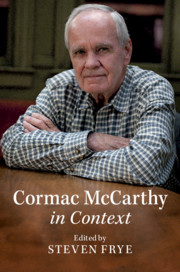Book contents
- Cormac McCarthy in Context
- Cormac McCarthy in Context
- Copyright page
- Contents
- Contributors
- Acknowledgments
- Chronology
- Part I Environments
- Part II Literary Contexts: Sources, Influences, Allusions
- Part III Intellectual Contexts
- Part IV Social and Cultural Contexts
- Chapter 18 North American Politics
- Chapter 19 Race and Cultural Difference
- Chapter 20 Ecology
- Chapter 21 Modernity
- Chapter 22 A Visual Artist and McCarthy
- Chapter 23 Cinematic Adaptations
- Chapter 24 Cinematic Influences
- Part V Archives, Critical History, Translation
- Works Cited
- Index
Chapter 23 - Cinematic Adaptations
from Part IV - Social and Cultural Contexts
Published online by Cambridge University Press: 12 December 2019
- Cormac McCarthy in Context
- Cormac McCarthy in Context
- Copyright page
- Contents
- Contributors
- Acknowledgments
- Chronology
- Part I Environments
- Part II Literary Contexts: Sources, Influences, Allusions
- Part III Intellectual Contexts
- Part IV Social and Cultural Contexts
- Chapter 18 North American Politics
- Chapter 19 Race and Cultural Difference
- Chapter 20 Ecology
- Chapter 21 Modernity
- Chapter 22 A Visual Artist and McCarthy
- Chapter 23 Cinematic Adaptations
- Chapter 24 Cinematic Influences
- Part V Archives, Critical History, Translation
- Works Cited
- Index
Summary
Cormac McCarthy is the foremost American novelist to have simultaneously inspired and crafted screenplays which are successful in their own right. Beginning with his early script for The Gardener’s Son (1977) and continuing through both the Coen brothers’ film adaptation of No Country for Old Men (2007) and his own screenplay for The Counselor (2013), McCarthy has emerged as a formidable figure on both the page and on screen. Yet the intriguing aspect of this dual career is how fully his cinematic efforts have altered the trajectory of his novelistic creations, with an early verbal style that culminated in the famously baroque Blood Meridian honed decades later into a more elliptical, streamlined novelistic strain. And this becomes most clearly apparent in reviewing the successes (and failures) involved in adapting McCarthy’s astringent novelistic vision for the cinema. The review of seven distinct original screenplays and adaptations suggests that the arc of McCarthy’s novels cannot be adequately understood independent of his strong, developing commitment to cinematic possibilities, which have progressively altered a vision initiated as exclusively verbal and become increasingly tempered by visual and filmic considerations.
Keywords
- Type
- Chapter
- Information
- Cormac McCarthy in Context , pp. 248 - 258Publisher: Cambridge University PressPrint publication year: 2020

